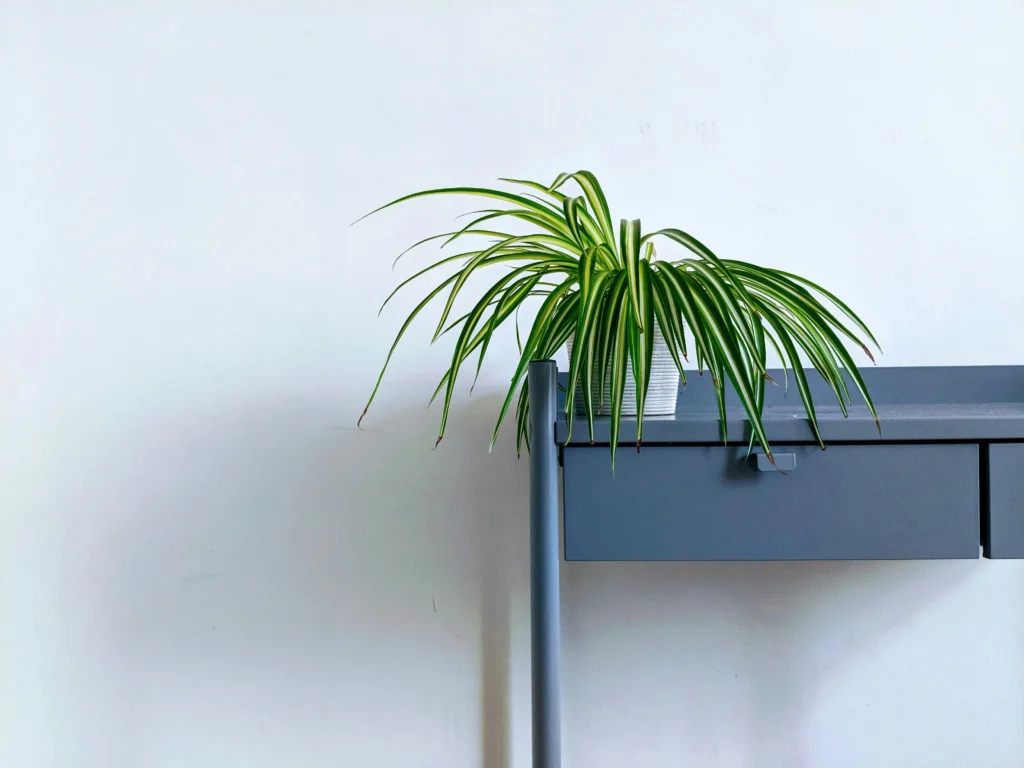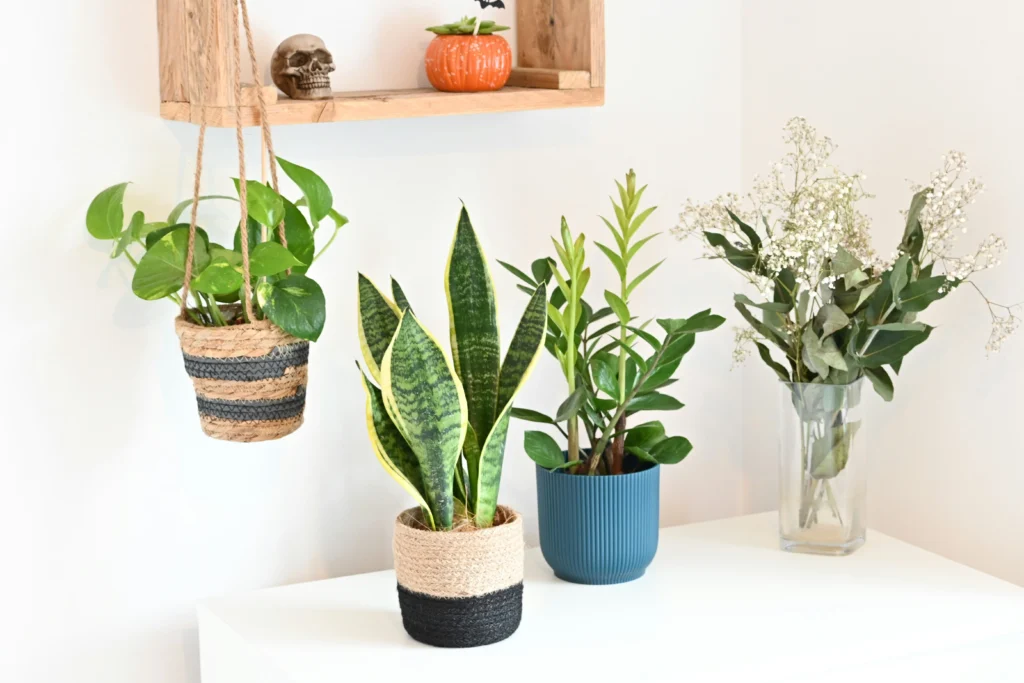The Best Indoor Plants for Air Quality in Your Home
Breathe easy, plant lovers: the secret to cleaner air might be hiding in your local nursery. The best indoor plants for air quality act as natural air purifiers, continuously working to cleanse our indoor environments of pollutants.
Many of us spend 90% of our time indoors (often surrounded by synthetic materials off-gassing various pollutants). Let’s explore how the best indoor plants for air quality, introduce you to the top performers in the leafy clean-air league and provide practical advice on incorporating these natural air filters into your living spaces.
The Science Behind Plants and Air Purification & The Best Indoor Plants for Air Quality
The best indoor plants for air quality function as living air filters, actively removing pollutants from your indoor environment. Their leaves act like sponges, soaking up gases through tiny pores called stomata. Once inside the leaf, many of these gases are converted into nutrients the plant can use. The plant’s roots and soil microorganisms also play a crucial role, breaking down pollutants into harmless byproducts.
NASA Clean Air Study
The idea of plants as air purifiers isn’t new, but it gained significant traction thanks to NASA. The NASA Clean Air Study, conducted in the late 1980s, was a groundbreaking research project that investigated the air-purifying capabilities of various plants in sealed environments, providing valuable insights for improving indoor air quality on Earth and in space.
This groundbreaking study revolutionized our understanding of indoor air quality and the role plants can play. It sparked further research and popularized the use of houseplants for air purification.
How Plants Filter Air
As air circulates around a plant, pollutants come into contact with leaf surfaces. The leaves absorb these pollutants through their stomata, tiny pores that open and close to regulate gas exchange.
Once inside the leaf, pollutants travel through the plant’s tissues. Some are used by the plant as nutrients, while others are broken down into less harmful substances. The plant’s roots also play a crucial role. They absorb pollutants that settle into the soil, aided by microorganisms living around the roots.
Different parts of the plant are more efficient at filtering different pollutants. Leaves are generally better at capturing gases like formaldehyde and benzene, while roots excel at removing larger particulate matter.
While plants work continuously to clean the air, noticeable improvements in air quality typically occur over weeks or months, depending on the number and type of plants, the size of your space, and the level of pollutants present.
The Best Plants for Indoor Air Quality
The performance of even the best indoor plants for air quality can be influenced by environmental factors such as light, temperature, and humidity.
1. Spider Plant
The spider plant (Chlorophytum comosum) is a air-purifying powerhouse that’s also incredibly easy to grow. With its arching leaves and dangling plantlets, it’s as decorative as it is functional.
Spider plants are particularly effective at removing formaldehyde, xylene, and toluene from the air. One of the best features of spider plants is their ability to produce babies (called “spiderettes”) that can be easily propagated, allowing you to multiply your air-cleaning army with minimal effort.
Proper spider plant care involves watering when the top inch of soil feels dry and providing occasional fertilization with a balanced nutrient solution, ensuring optimal growth and air-purifying performance. They’re tolerant of neglect and can bounce back from occasional overwatering, making them perfect for beginners.
*One potential drawback: if you have cats, be aware that spider plants can have a mildly hallucinogenic effect on them. While not toxic, you might find your feline friend batting at the leaves more than usual!
Looking to bring some more cleanliness and air inside and outside of your home? Explore Geek Window Cleanings’ ACP Program for ongoing house cleaning!
2. Snake Plant
The snake plant (Sansevieria trifasciata) is a tough, adaptable air purifier that thrives on neglect. Also known as mother-in-law’s tongue, this plant has tall, upright leaves that make a striking visual statement.
One of the key snake plant benefits is its ability to perform photosynthesis at night, converting CO2 to oxygen and making it an ideal choice for bedroom air purification. Similar to how cacti store up carbon dioxide at night to save water, spider plants take in CO2 at night when it’s cooler and use it in the photosynthesis process during the day for energy. They’re also highly effective at removing formaldehyde, xylene, and toluene from the air.
Snake plants are incredibly low-maintenance. They can tolerate low light conditions and irregular watering. In fact, it’s better to underwater than overwater these hardy plants. They’re also resistant to most pests, making them a worry-free choice for busy households.
When it comes to air purification, snake plants are particularly effective against trichloroethylene, a chemical found in many household cleaners and adhesives.
Explore our Houston window cleaning services to keep the exterior of your home as good as new!
3. Peace Lily
When it comes to the peace lily, air cleaning is just one of its many talents! (Spathiphyllum) combines elegant beauty with powerful air-purifying abilities. Its glossy green leaves and white “flowers” (actually modified leaves called spathes) add a touch of sophistication to any room.
Peace lilies are workhorses when it comes to air purification. They’re effective against a wide range of pollutants, including formaldehyde, benzene, trichloroethylene, xylene, and ammonia. They’re particularly good at removing acetone, which is found in nail polish remover and some paints.
These plants prefer low to medium light and like to be kept consistently moist, but not waterlogged. They’ll dramatically droop when they need water, making it one of many low-maintenance houseplants that you’ll easily know when to care for..
One word of caution: peace lilies are toxic if ingested, so keep them out of reach of curious pets and children.
4. Bamboo Palm
The bamboo palm (Chamaedorea seifrizii) brings a touch of the tropics to your home while purifying your air. With its lush, feathery fronds, it’s a beautiful addition to any room.
The bamboo palm (indoor use) are excellent humidifiers, adding moisture to dry indoor air. They’re also effective at removing formaldehyde, benzene, and trichloroethylene from the air.
These palms prefer bright, indirect light and consistently moist soil. They can grow quite large, reaching up to 12 feet tall, so make sure you have space for them to mature. Regular misting can help keep their leaves dust-free and looking their best.
Bamboo palms are particularly effective at filtering xylene and toluene, chemicals often found in paints and varnishes.
5. Aloe Vera
Aloe vera isn’t just for sunburns – it’s also one of many great air-purifying plants! This succulent plant is as useful as it is attractive, with fleshy, spiky leaves that store water.
Aloe vera is particularly effective at removing formaldehyde and benzene from the air. As a bonus, the gel inside its leaves has numerous medicinal properties, making it a dual-purpose plant for health and air quality.
These plants are incredibly low-maintenance. They prefer bright, direct sunlight and well-draining soil. Water only when the soil is completely dry – aloe vera is drought-tolerant and prone to root rot if overwatered.
Interestingly, aloe vera can serve as an indicator of poor air quality. If brown spots appear on its leaves, it might be a sign of high levels of indoor pollutants.
Placement Strategies & Care
Strategic placement of your air-purifying plants can maximize their effectiveness and enhance your home’s aesthetic appeal.
High-Traffic Areas
High-traffic areas like living rooms and entryways can benefit greatly from air-purifying plants. These areas often have the highest concentration of airborne pollutants due to constant activity.
Plants that work well in high-traffic areas include:
- Spider plants: They’re tough and can handle occasional bumps.
- Rubber plants: Their large leaves are excellent air purifiers.
- Dracaena varieties: They come in various sizes to fit different spaces.
Beyond air purification, plants in communal spaces can have significant psychological benefits. They can reduce stress, improve mood, and create a more welcoming environment for both residents and guests.
Bedrooms and Home Offices
Air quality is particularly important in bedrooms and home offices, where we spend a significant amount of time. Good air quality in these spaces can improve sleep quality and boost productivity.
For bedrooms, consider plants that release oxygen at night, such as:
- Snake Plants
- Aloe Vera
- Orchids
For home offices, plants that improve focus and reduce stress are ideal:
- Peace Lily
- English Ivy
- Bamboo Palm
When placing plants in these rooms, consider light levels carefully. Bedrooms often have lower light levels, so choose plants that can tolerate shade. In home offices, be mindful of plant placement to avoid glare on computer screens.
Remember, it’s important to keep your windows clean to make sure your plants have optimal exposure to light! Check out our post on how to maintain your glass windows!
Studies have shown that plants in work environments can increase productivity and creativity. In bedrooms, they can contribute to better sleep quality by improving air purity and increasing humidity.
Combining Plants with Other Air-Purifying Methods
While plants are excellent air purifiers, combining them with other methods can create a comprehensive approach to indoor air quality!
Air Purifiers and Plants
While plants excel at removing certain gases and producing oxygen, air purifiers are more effective at capturing particulate matter and some volatile organic compounds (VOCs).
Consider placing air purifiers in areas where plants might struggle, such as low-light corners. Ensure that airflow from purifiers doesn’t directly hit plants, as this can dry them out. Some air purifiers even have settings designed to work alongside plants, optimizing air circulation without harming your green friends.
Natural Ventilation Techniques
Simple techniques like opening windows on opposite sides of a room can create cross-ventilation, efficiently replacing stale indoor air with fresh outdoor air. In colder months, even brief periods of ventilation can significantly improve air quality without drastically affecting indoor temperature.
Consider creating a schedule for ventilation, such as opening windows for 5-10 minutes every few hours. This can be especially beneficial in areas where plants are located, as it helps remove any pollutants they’ve absorbed from the air.
Natural ventilation can also help regulate humidity levels, which is beneficial for both your plants and your home’s overall air quality. Just be mindful of outdoor air quality and pollen levels, especially if you have allergies.
Interior & Exterior Home Cleaning: Call Up Geek Window Cleaning Today!
After you’ve perfected the air quality indoors, start creating a more beautiful home outdoors, too! Geek Window Cleaning has professional-grade equipment to maintain your glass windows and gutters as good as new so you can remove dirt allergens from the outside of your home, too!
Explore our window cleaning services and our ACP window cleaning program — contact us today!





Recent Comments